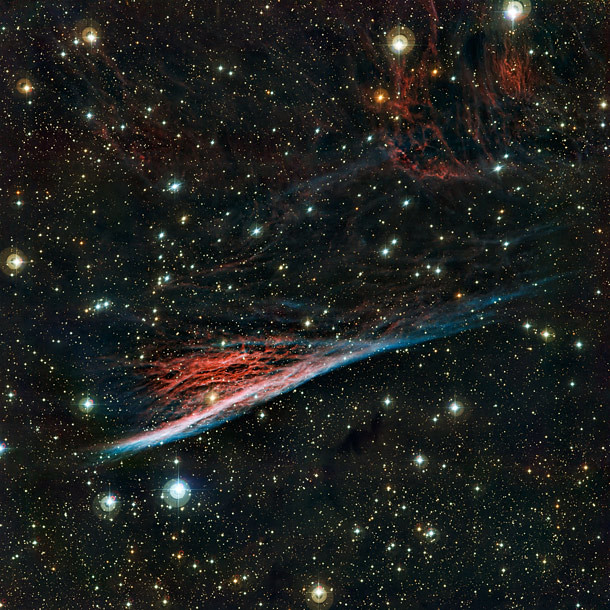Create a free profile to get unlimited access to exclusive videos, sweepstakes, and more!
The subtlety of cosmic violence

One of the most amazing things I can think of can be stated simply: some stars explode.
That's incredible. An entire star, millions of kilometers across and massing octillions of tons, can go supernova, tearing itself to shreds. The explosion is so huge that it releases more energy in a few months than our Sun will over its entire lifetime.
And yet, when seen from a distance, supernovae can produce structures of astonishing subtlety and beauty. About 11,000 years ago, a star over 800 light years away exploded in the constellation Vela, producing an expanding gas cloud. Here is one small part of that nebula:
[Click to chandrasekharenate, or grab the ginormous 8300 x 8300 pixel version.]
That gorgeous structure is NGC 2736, also called the Pencil Nebula, part of the much larger Vela supernova remnant. This picture was taken using the 2.2 meter MPG/ESO telescope in Chile. As the debris from the titanic explosion expands, it rams into the interstellar gas surrounding it. That compresses the gas, and drives a shock wave through it. A shock wave occurs when an object moves at supersonic speed through some other material - although the gas in space is thin, in some places it's thick enough that atoms and molecules in it do collide. It's still a thin vacuum by our standards, but physics will not be denied.
Think of it this way: imagine two people standing a few meters apart, holding a rope between them. One of them snaps their end up and down sharply. A wave is created which moves down the rope, and a second or so later the other person feels the tug. The information that the first person moved the rope took some amount of time to travel down the rope in the form of that wave.
Sound is similar, in that it's a compression wave. When something happens to make a sound - like a tree falling in a forest - it compresses the air, and that compression moves outward at (duh) the speed of sound. It's a way of transmitting information from one spot to another.
But now imagine something moving faster than sound. Instead of hearing the sound first, the supersonic object would actually travel past you before its sound would. Because you didn't hear anything first, that event would surprise you, right? You might even be... shocked.
Hence the term shock wave.
And that's what's happening in NGC 2736. The gas from the supernova is expanding far faster than sound in the surrounding gas, so the gas is shocked. It gets hugely compressed, and forms those thin filaments and ribbons. You see this a lot in space where one thing is slamming into another (see Related Posts below). The energy of the shock wave heats up the gas, which then glows, and from a safe distance we see it as a thread of light, finely detailed and structured.
They say that in space, no one can hear you scream... but in reality, if you pick the right place and scream hard enough, you can make yourself heard across thousands of years in time, and trillions of kilometers in space.
Image credit: ESO
Related Posts:
- Revealing the Veil
- The beating heart of W5
- A dying star with the wind in its hair
- The cold, thin, glorious line of star birth



























